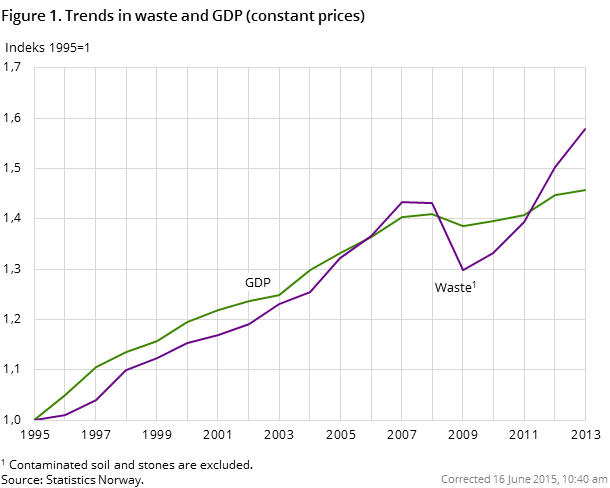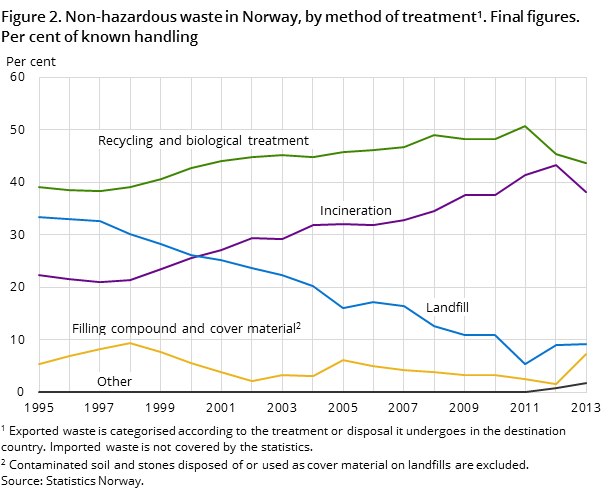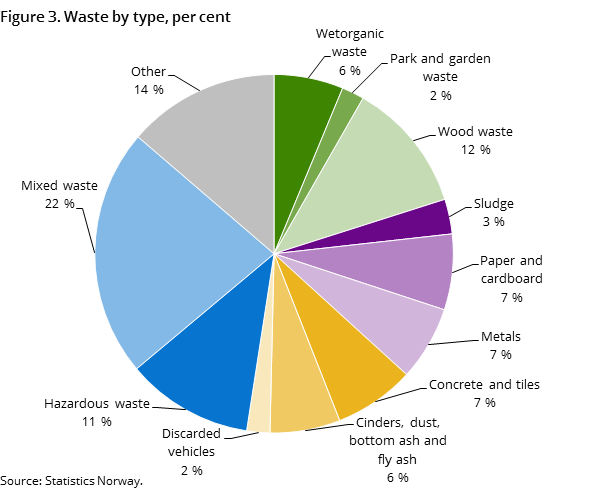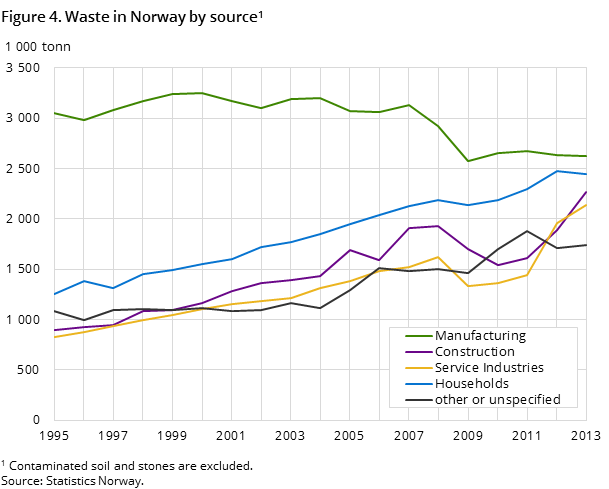Content
Published:
This is an archived release.
More waste – more sources
The total amount of waste in Norway increased by 5 per cent from 2012 to 2013. In 2013, a total of 11.2 million tonnes of waste was generated. This increase is mainly due to recent improvements in data availability.
| 2013 | Change in per cent 2013-2012 | ||
|---|---|---|---|
| 1 000 tonnes | Share % | ||
| Source of origin, total | 11 204 | 100 | 5 |
| Manufacturing industries | 2 620 | 23 | -1 |
| Households | 2 440 | 22 | -1 |
| Construction and demolition | 2 264 | 20 | 20 |
| Service industries | 2 140 | 19 | 9 |
| Other or unspecified | 1 740 | 16 | 2 |




Waste amounts have been steadily increasing over the last few years, and this tendency continued for 2013. However, the increase from 2012 to 2013 is mainly a result of the availability of new waste data sources and the inclusion of data from more sectors than previously. Without these two factors, the increase from 2012 to 2013 would have been less than one per cent. At the same time, the value added measured by GDP (constant prices) has increased by less than one per cent from 2012 to 2013.
The fraction of waste that is recovered is stable
In 2013, the total recovery of non-hazardous waste undergoing known treatment was 81 per cent; the same as for 2012. This corresponds to 7.9 million tonnes. In 2013, 30 per cent of non-hazardous waste undergoing known treatment was energy recovered, while 36 per cent was subject to material recovery.
The amount of waste incinerated decreased somewhat from 2012 to 2013, but is still very high, with 4.0 million tonnes in 2013. It is still mixed waste and wood waste that constitute the largest fractions for incineration. Increased amounts of asphalt from construction compared to earlier years helped keep the recovery at the same level as in 2012.
The amount of waste going to landfill has also increased in 2013. In 2013, around 9 per cent of non-hazardous waste undergoing known treatment was deposited. The increase in deposited waste is partly due to increased amounts of secondary waste from waste incineration. However the largest fraction being deposited is hazardous waste.
Most mixed waste
The major waste material categories in 2013 were mixed waste, which had 22 per cent of the total, followed by wood waste with 12 per cent and hazardous waste with 11 per cent. These are the same three categories of waste that topped the list in 2012.
The manufacturing industry still contributes the largest amounts of waste
The manufacturing industry is still the source of the largest amount of waste, with 2.6 million tonnes or 23 per cent of the total in 2013, followed by households (22 per cent) and the construction and demolition industry (20 per cent). Both the waste amounts from the manufacturing industry and households are similar to the amounts in 2012. However the amounts of waste from building and construction have seen a sharp increase from 2012. This is apparently because a new source of data on asphalt from construction has been used to calculate the 2013 figures. Without this new data source the amounts of waste from this industry would also have been similar to 2012. We have not calculated the amounts of asphalt for previous years in connection with this article.
The industry with the largest decrease in waste amounts is mining and quarrying, with a drop of 19 per cent in 2013 compared with 2012. This decrease is mainly due to less hazardous waste.
Masses for landfilling and cover materials
While ordinary waste sent for landfill has increased in the last year, the amounts of slightly polluted soil that are deposited have decreased. In 2013, 1.3 million tonnes were sent to ordinary landfills and 60 000 tonnes were used as cover material. This is a decrease compared to 2012, where a total of 1.6 million tonnes was deposited or used as cover materials.
Changes in the waste account: Methodology and categoriesOpen and readClose
Prior to publication of figures for 2012, the waste account was subject to major changes in both methodology and published categories. Mixed waste is one of the categories. This means that large amounts of wet organic waste, paper and plastics, which were previously published in their own category, are now also part of mixed waste. More details of this change are available in About the statistics.
More sources of waste are added to the waste account and other changes are madeOpen and readClose
The waste account for Norway is still under development. Compared to 2012, more asphalt from construction is added. This contributes more than 400 000 tonnes.
Waste from the industry wholesale of waste and scrap is also included for the 2013 publication. This industry is included in the service industry.
For the 2013 publication, concrete and tiles reused at construction sites are placed in the treatment category filling compound and cover material. These amounts were previously placed under sent to material recovery.
Contact
-
Camilla Skjerpen
E-mail: camilla.skjerpen@ssb.no
tel.: (+47) 48 22 72 14
